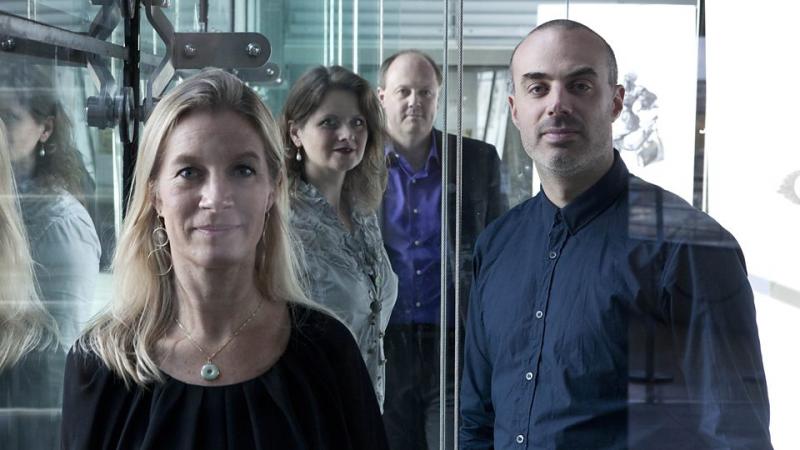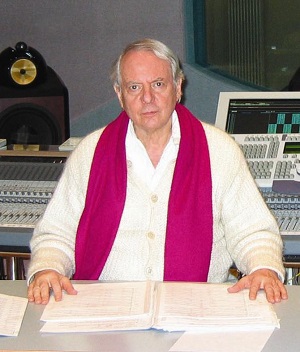Theatre of Voices, Kings Place review - fluidity and dynamism in Stockhausen | reviews, news & interviews
Theatre of Voices, Kings Place review - fluidity and dynamism in Stockhausen
Theatre of Voices, Kings Place review - fluidity and dynamism in Stockhausen
Danish ensemble balances ritual, drama and comedy in 'STIMMUNG'

The last time Theatre of Voices performed Stockhausen’s STIMMUNG in London was at the Albert Hall, at a late night Prom in 2008, so Kings Place made for a much more intimate setting. In fact, the work, which is for six unaccompanied voices, relies heavily on electronic amplification, so can be adapted to almost any environment. And Kings Place proved perfect, with its sympathetic acoustic and hi-tech audio array.
In STIMMUNG, six singers sit cross-legged around a low circular table, illuminated by a central light – in this case a 3D-printed scale model of the moon. Most of the music is based on overtone throat singing, but with many other elements added in. Theatre of Voices, a Copenhagen-base ensemble, have much experience with the work and are able to finely balance its competing demands, for ritual, musical drama, and even slapstick comedy. The ritual is acknowledged in their attire – all wear Indian-looking pastel linens – and in their solemn entrance and bow to each other before the performance commences.
But as the work unfolds, the solemnity is left behind, and the real strength of this performance was the fluidity and dynamism of the ensemble. STIMMUNG plays out as a single 70-minute span, but it is made up of 51 short sections (the group must first decide on the order in which they are to be sung – this was the “Copenhagen version” they devised in 2006). Within those sections, there is often a big dramatic effect, a storm of repeated consonants that grows to a frenzy, or a shared vowel sound gradually disappearing to silence. Theatre of Voices make the most of these localised effects. Their ensemble is always tight, but their tempos (or apparent tempos, it’s a graphic score) are fluid, sometimes gradually changing, but just as often switching in an instant. That is particularly effective in the transitions, where typically a single voice continues with the previous music while the other singers switch to a contrasting tempo and sound.
 The performance shared many strengths with another recent STIMMUNG in London, by Singcircle at the Barbican in November (Theatre of Voices founder Paul Hillier is the link between the groups, but wasn’t present at either concert). Singcircle made much of the ritual quality of the music, and their reading was more solemn and more imposing. But Theatre of Voices scored over them in several important respects. Most significantly, the voices here were younger and more flexible, and also better integrated as an ensemble. That allowed for the greater dynamic contrasts and also brought more clarity to the textures. Although all here were impressive, the men really shone. Special mention should go to bass-baritone Jakob Bloch Jespersen, whose rich low register has the ideal dramatic potential for Stockhausen’s (pictured above by Kathinka Pasveer) many interludes and diversions, and also to tenor Wolodymyr Smishkewych, who is a master of the overtone singing, producing all sorts of high-pitched whistles and wails when required. The final ingredient here that set the performance above the competition was the sound design of Ian Dearden, admittedly working with the impressive audio array at Kings Place, but producing a suitably immersive soundscape, well balanced between the singers and always natural sounding.
The performance shared many strengths with another recent STIMMUNG in London, by Singcircle at the Barbican in November (Theatre of Voices founder Paul Hillier is the link between the groups, but wasn’t present at either concert). Singcircle made much of the ritual quality of the music, and their reading was more solemn and more imposing. But Theatre of Voices scored over them in several important respects. Most significantly, the voices here were younger and more flexible, and also better integrated as an ensemble. That allowed for the greater dynamic contrasts and also brought more clarity to the textures. Although all here were impressive, the men really shone. Special mention should go to bass-baritone Jakob Bloch Jespersen, whose rich low register has the ideal dramatic potential for Stockhausen’s (pictured above by Kathinka Pasveer) many interludes and diversions, and also to tenor Wolodymyr Smishkewych, who is a master of the overtone singing, producing all sorts of high-pitched whistles and wails when required. The final ingredient here that set the performance above the competition was the sound design of Ian Dearden, admittedly working with the impressive audio array at Kings Place, but producing a suitably immersive soundscape, well balanced between the singers and always natural sounding.
Kings Place took an unusually didactic approach to the presentation of this concert. The publicity offered an English translation of the work’s nebulous title: “Tuning In”. And the programme (with exemplary notes from Tim Rutherford-Johnson) included a “cast list” of all the gods whose names are intoned in the work, as well as a full translation of the erotic poetry, written by Stockhausen’s then wife, that make up much of the work’s text. That might have been an annotation too far, given how most of us try to hide behind our monoglot ignorance when these sections crop up, although given the crystal clear, and highly suggestive delivery here, that was always going to be a tall order. But best of all, the performance began with an introduction from the singers, where the audience was encouraged to try out the overtone singing for ourselves. It didn’t sound much like the professionals, but it was a lot of fun!
rating
Share this article
The future of Arts Journalism
You can stop theartsdesk.com closing!
We urgently need financing to survive. Our fundraising drive has thus far raised £49,000 but we need to reach £100,000 or we will be forced to close. Please contribute here: https://gofund.me/c3f6033d
And if you can forward this information to anyone who might assist, we’d be grateful.

Subscribe to theartsdesk.com
Thank you for continuing to read our work on theartsdesk.com. For unlimited access to every article in its entirety, including our archive of more than 15,000 pieces, we're asking for £5 per month or £40 per year. We feel it's a very good deal, and hope you do too.
To take a subscription now simply click here.
And if you're looking for that extra gift for a friend or family member, why not treat them to a theartsdesk.com gift subscription?
more Classical music
 From Historical to Hip-Hop, Classically Black Music Festival, Kings Place review - a cluster of impressive stars for the future
From quasi-Mozartian elegance to the gritty humour of a kitchen inspection
From Historical to Hip-Hop, Classically Black Music Festival, Kings Place review - a cluster of impressive stars for the future
From quasi-Mozartian elegance to the gritty humour of a kitchen inspection
 Shibe, LSO, Adès, Barbican review - gaudy and glorious new music alongside serene Sibelius
Adès’s passion makes persuasive case for the music he loves, both new and old
Shibe, LSO, Adès, Barbican review - gaudy and glorious new music alongside serene Sibelius
Adès’s passion makes persuasive case for the music he loves, both new and old
 Anja Mittermüller, Richard Fu, Wigmore Hall review - a glorious hall debut
The Austrian mezzo shines - at the age of 22
Anja Mittermüller, Richard Fu, Wigmore Hall review - a glorious hall debut
The Austrian mezzo shines - at the age of 22
 First Person: clarinettist Oliver Pashley on the new horizons of The Hermes Experiment's latest album
Compositions by members of this unusual quartet feature for the first time
First Person: clarinettist Oliver Pashley on the new horizons of The Hermes Experiment's latest album
Compositions by members of this unusual quartet feature for the first time
 Gesualdo Passione, Les Arts Florissants, Amala Dior Company, Barbican review - inspired collaboration excavates the music's humanity
At times it was like watching an anarchic religious procession
Gesualdo Passione, Les Arts Florissants, Amala Dior Company, Barbican review - inspired collaboration excavates the music's humanity
At times it was like watching an anarchic religious procession
 Classical CDs: Camels, concrete and cabaret
An influential American composer's 90th birthday box, plus British piano concertos and a father-and-son duo
Classical CDs: Camels, concrete and cabaret
An influential American composer's 90th birthday box, plus British piano concertos and a father-and-son duo
 Cockerham, Manchester Camerata, Sheen, Martin Harris Centre, Manchester review - re-enacting the dawn of modernism
Two UK premieres added to three miniatures from a seminal event of January 1914
Cockerham, Manchester Camerata, Sheen, Martin Harris Centre, Manchester review - re-enacting the dawn of modernism
Two UK premieres added to three miniatures from a seminal event of January 1914
 Kempf, Brno Philharmonic, Davies, Bridgewater Hall, Manchester review - European tradition meets American jazz
Bouncing Czechs enjoy their Gershwin and Brubeck alongside Janáček and Dvořák
Kempf, Brno Philharmonic, Davies, Bridgewater Hall, Manchester review - European tradition meets American jazz
Bouncing Czechs enjoy their Gershwin and Brubeck alongside Janáček and Dvořák
 Solomon, OAE, Butt, QEH review - daft Biblical whitewashing with great choruses
Even a top soprano and mezzo can’t make this Handel paean wholly convincing
Solomon, OAE, Butt, QEH review - daft Biblical whitewashing with great choruses
Even a top soprano and mezzo can’t make this Handel paean wholly convincing
 Two-Piano Gala, Kings Place review - shining constellations
London Piano Festival curators and illustrious friends entertain and enlighten
Two-Piano Gala, Kings Place review - shining constellations
London Piano Festival curators and illustrious friends entertain and enlighten
 Echo Vocal Ensemble, Latto, Union Chapel review - eclectic choral programme garlanded with dance
Beautiful singing at the heart of an imaginative and stylistically varied concert
Echo Vocal Ensemble, Latto, Union Chapel review - eclectic choral programme garlanded with dance
Beautiful singing at the heart of an imaginative and stylistically varied concert
 Scott, Irish Baroque Orchestra, Whelan, RIAM, Dublin review - towards a Mozart masterpiece
Characteristic joy and enlightenment from this team, but a valveless horn brings problems
Scott, Irish Baroque Orchestra, Whelan, RIAM, Dublin review - towards a Mozart masterpiece
Characteristic joy and enlightenment from this team, but a valveless horn brings problems

Add comment